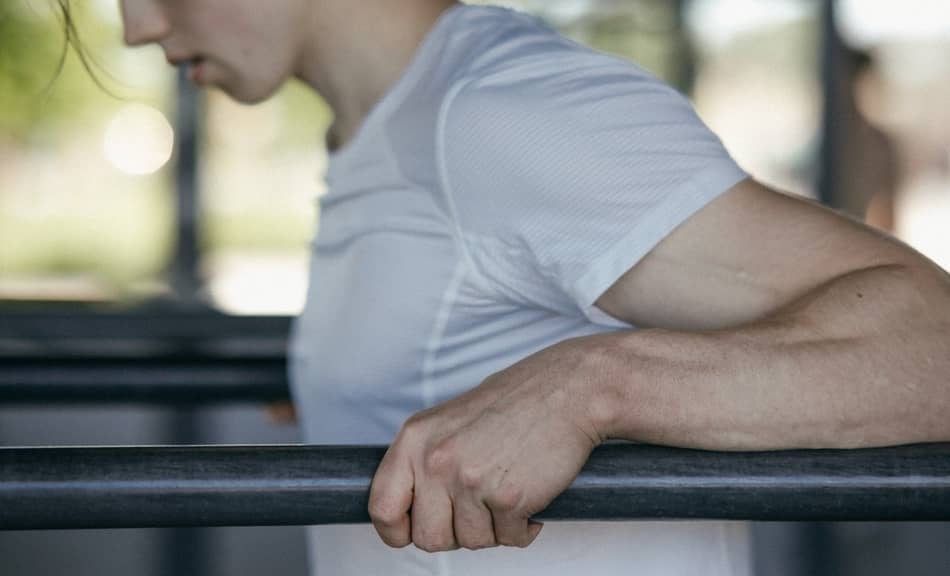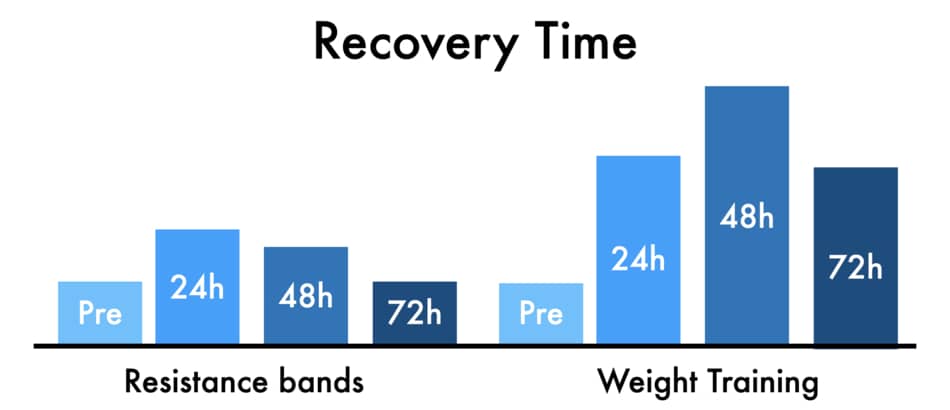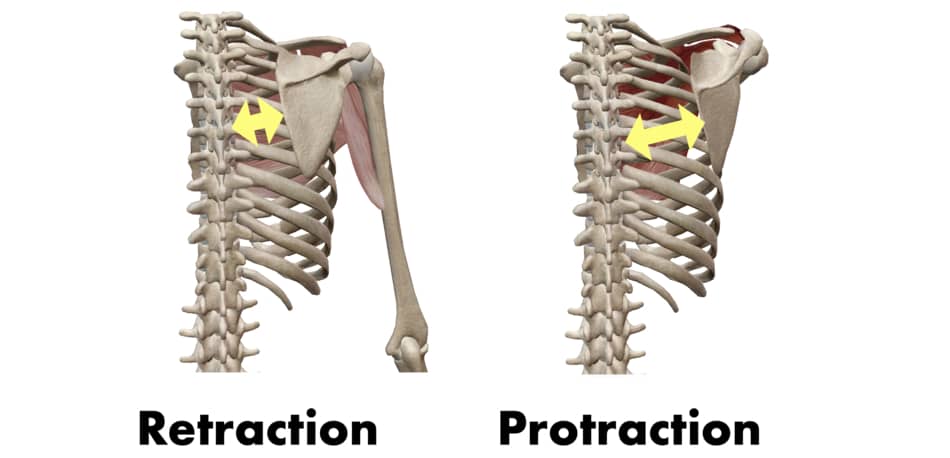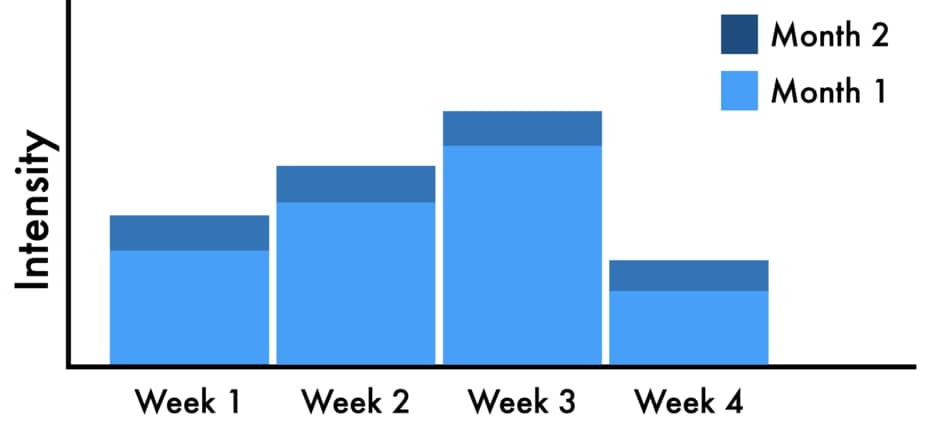I get lots of questions from my clients who use peloton about how to build strong chest. In this article, I will clarify if you can build a chest on a peloton, and if so, which classes should you choose.
Overall, the peloton does give a good chest workout because it includes multiple exercises that engage all the areas of the chest muscles. It also uses many variations of exercises like pulses, pauses, isometric holds, as well as super-sets to increase time under tension.
Keep reading to learn which peloton classes help activate chest muscles and hit the muscle fibers from all possible angles.

NOTE: This is not an article about mechanisms behind muscle growth. I’ve already covered that in my article “does peloton build muscle“, which I recommend you read.
Best Peloton Chest Workouts
Overall, it is possible to build a strong chest without access to a gym or heavy weights because you can substitute resistance with volume. Doing high repetitions of functional bodyweight exercises is equally effective in stimulating muscle protein synthesis.
This means you can build the muscle mass, but it will take longer.
Are high-volume chest workouts good? Overall, the high-volume chest workouts are good because they allow maximizing muscle growth. Also, doing more repetitions is effective to increase heart rate, especially if it’s done with minimum rest in between sets. This helps to burn more calories, without adding extra cardio.
Does peloton have a chest workout? As a whole, the peloton does have over 500 upper body workouts, and the majority of them are for the chest and back.
These classes utilize a circuit training style where you do multiple exercises, back to back. They also use both free weights, as well as bodyweight movements.
What chest exercises does peloton use? Overall, the peloton use multiple different chest exercises like pushups, floor press, wide-grip pushups, hindu pushups, as well as chest stretches. Pushups are effective to build arms and chest because they don’t induce high muscle damage, comparing to heavy bench press.
Here are the best peloton chest classes for bigger and stronger chest.
#1 Chest and Back Strength
Building a strong chest may seem difficult if you don’t train at the gym and don’t use all the machines.
However, peloton strength has dedicated “chest and back” classes, which is enough to stimulate hypertrophy with just the lightweight and bodyweight exercises.
What is peloton chest and back strength? As a whole, the peloton chest and back strength is the most popular class on the peloton for the upper body. It’s a series of classes that last between 20 to 30 minutes, all designed to work on the chest, back, arms and shoulders.
Why peloton chest and back strength is effective? Overall, this class is effective for building chest muscles because it has the highest variety of push exercises that target most of the chest muscle fibers. It also has the right push-to-pull ratio that prevents common injuries like rotator cuff tendinosis.
What I like about the peloton chest workouts is that each class is balanced with enough volume that covers both pressing and pulling movements.
People who want a bigger chest and tend to only focus on the bench press or push-ups tend to overdevelop pectorals and underdevelop retractor muscles.
This predisposes to most common injuries around the shoulder because of imbalance.
#2 Power Yoga
Generally, yoga can build chest muscles, as long as you prioritize arm balancing poses, backbends and inversions. The best asanas to work on your chest would include chaturanga, crane pose, swan pose, as well as sun salutation sequence.
Keep in mind that yoga is a broad term and includes several styles.
The peloton power yoga is the best yoga class to build a strong chest because it includes intermediate to advanced poses like cobra pose, scorpion pose, headstand, and a variety of planks.
It also includes several transitions from floor to standing, which requires chest and shoulder work.
What I like about power yoga is it combines bodyweight and isometric holds as a way to leverage the effort level.
With each arm balancing pose, you need to either hold the position for a number of breaths or move slowly through the full range of motion.
This not only creates muscle fatigue but also opens room for progression because you can always try to hold the asanas for longer.
#3 Resistance Bands
Peloton resistance bands are another germ workouts that are underrated when it comes to chest development. Each class has medium to high reps with short rest periods, for multiple sets.
Does the peloton have resistance bands chest workouts? Overall, the peloton does have resistance bands chest workouts available in the “strength” category. To find the classes use the filter tab and select “resistance bands”, then further search for upper body or full body classes.
What I love about doing peloton resistance bands chest workouts is they allow you to do a high number of reps, without feeling sore the next day.
That’s because bands workouts create metabolic stress in the muscle, which is the feeling of the burning sensation and the “pump” in the muscles. This type of training is highly effective at inducing hypertrophy, even with lower levels of resistance.
Not only that.
It also doesn’t peak the muscle soreness (comparing to lifting heavy weights), which means you can do it on a daily basis.
Here in the graph, you can see how much time muscles need for recovery with resistance bands vs weights.

On the other hand, if you train with heavy weights you create muscle damage and mechanical tension. They are both effective for building muscle, but they also need more time for recovery.
As you can see, adding more resistance bands training can be used either on its own or as an addition to your existing weight training routine.
#4 Focus Flow Chest Openers
The peloton focus flow chest opener is the recovery practice to balance other chest workouts. It counteracts the effects of hard push exercises by stretching the muscles and restoring optimal range of motion.
What are chest openers? Overall, the peloton chest openers are the yoga classes that help to improve posture, reduce muscle tension, and lengthening the spine. It can be used after a long day of sitting, as well as on recovery day to stretch tight chest and shoulder muscles.
Are chest openers effective in growing muscle? Generally, the chest openers don’t stimulate muscle growth, but they help to recover faster from high-volume workouts. Those sessions are great in preventing muscle soreness, especially after doing high reps with the bodyweight and dumbbell exercises.
Personally, I like to do combine chest openers with other restorative yoga classes, at least once per week. Here is an example of my peloton yoga combo for a recovery day.
- Sun Salutation (10 minutes)
- Chest Openners (20 minutes)
- Restorative yoga (20 minutes)
I would typically do them one after another, back to back.
This way not only I can speed up my recovery, but also it helps me feel less stressed.
How To Build Chest With Peloton?
You already know which classes are the best for building pecs. Now lets look at how to use those workouts to get the best results.
Here are the 5 tips on how to build chest with peloton classes.
- Remember about posture – Keeping the right posture is by far the most important element in chest training. With each rep need to be mindful about keeping your shoulder externally rotated and scapula retracted.
Retraction is when you squeeze your shoulder blades together and open the chest.

This helps with muscle activation. Doing chest exercises, without correct technique can put lots of pressure on the shoulders, not chest.
- Hit the muscle 3 times per week – Doing chest strength class once a week is not enough to facilitate muscle growth. Try to hit the chest at least 3 times per week (but don’t do it back to back).
Here is an example of peloton training (with emphasis on chest).
| Day of the week | Peloton class |
|---|---|
| Monday | Chest and Back Strength |
| Tuesday | HIIT Ride |
| Wednesday | Power Yoga |
| Thursday | Power Zone Endurance Ride |
| Friday | Resistance Bands Upper Body |
| Saturday | HIIT Cardio |
| Sunday | Chest Openers Restorative Yoga |
As you can see, in this plan you have enough variety to training the muscle in multiple angles. You also alternate your upper body strength days with cardio workouts to prevent muscle soreness.
Also, keep in mind that some of the peloton HIIT cardio classes got many chest and shoulder exercises that are worth checking.
- Choose 20 minute wokrouts – Increase training volume by adding more frequency, not the duration. Twenty minutes is long enough to fatigue the muscle, but not too long to induce DOMS (delayed onset muscle soreness).
As the weeks go by and the body gets more adapted to the workouts, you can slowly add more duration to increase overall training volume.
- Use periodization – Periodization means working with a plan that implement progressive overload, which has high-intensity training days, as well as recovery days.
Below you can see example of 4 week chest training program.

In the graph you can see the classic periodization breakdown. First 3 weeks you gradually increase intensity (class duration, difficulty level, frequency of the classes).
In the last week of the month, you reduce all workouts down to the “recovery line”. This is the week where you can do more chest openers and restorative yoga, as well as recovery rides.
On the 5th week, you start again, but this time you go 10-20% harder than on week 1. This periodization process is widely used in several training plans – including marathon and triathlon training.
- Use advanced classes – The difference between advanced and beginner classes is that advanced workouts use more difficult exercises. I think the best peloton instructor for upper body classes is Adrian Williams.
He not only has the best chest exercises variety, but he also manipulates with the tempo, as well as with range of motion.
Slowing down the moves and modifying the range of motion increases muscle fiber recruitment.
Conclusion
Ideally, to build chest you would use variety of machines that are available in the gym like cables, pec dec, smith machine and heavy beanch press. Those exercises have been time-proven to develop strong looking muscle.
But as you can see, building a chest at home i also possible, as long as you hit the muscle from different directions, as well as increase the training frequency.
